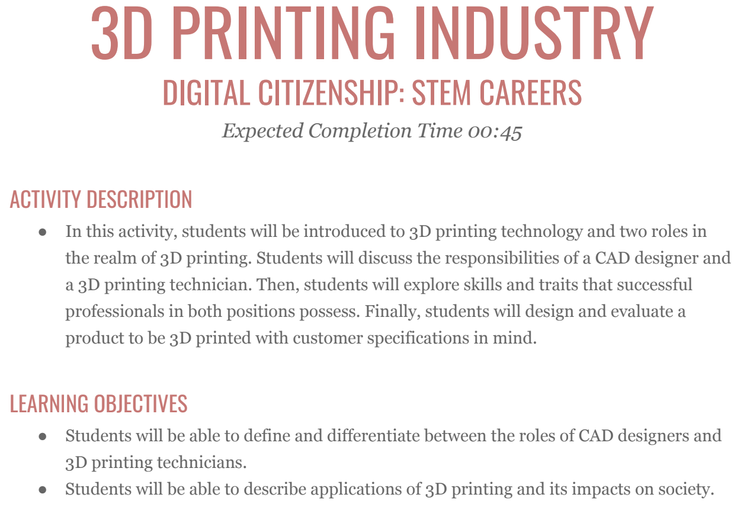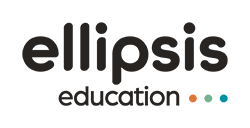Maine K-12 Computer Science Standards
Download a free 6-8 STEM Career lesson to engage your students in STEM and computer science. In this lesson, students will learn about the 3D printing industry.
Codelicious Computer Science Curriculum
Codelicious Computer Science Curriculum is grade-level differentiated, aligns with state and national computer science standards, and is continually updated to reflect changes in computer science. Since computer science is more than just coding, Codelicious courses include coding, unplugged, digital citizenship, and STEM career lessons as well as hardware integrations.
Free Computer Science Lesson

STEM CAREER LESSON PLAN
In 3D Printing Industry, students will be introduced to 3D printing technology and two roles in the realm of 3D printing. Students will discuss the responsibilities of a CAD designer and a 3D printing technician. Then, students will explore skills and traits that successful professionals in both positions possess. Finally, students will design and evaluate a product to be 3D printed with customer specifications in mind.
The lesson plan PDF includes links to the appropriate materials and resources, a detailed procedure, activity tips, and a bonus challenge activity.
Maine Computer Science Standards
The Maine Department of Education has an initiative to provide all K12 students with computer science opportunities. The state of Maine does not have state-wide computer science standards, and it is up to individual school districts to select the standards of their choosing. Many districts select the CSTA standards. In fact, Maine has their own CSTA chapter to help with the Maine DOE’s computer science initiative.
According to the CSTA standards, the concepts and subconcepts to be taught in each grade level are:
-
Computing Systems
-
Devices
-
Hardware and Software
-
Troubleshooting
-
-
Network and the Internet
-
Network Communication and Organization
-
Cybersecurity
-
-
Data and Analysis
-
Storage
-
Collection, Visualization, and Transformation
-
Inference and Models
-
-
Algorithms and Programming
-
Algorithms
-
Variables
-
Control
-
Modularity
-
Program Development
-
-
Impacts of Computing
-
Culture
-
Social Interactions
-
Safety, Law, and Ethics
-
If your school district chose an alternative standards set, you can explore other K-12 Computer Science Standards on our website. Aside from CSTA, other popular STEM standards bodies include ISTE, CTE, NGSS, and more.
The department of education supports continuous learning for educators. View a selection of professional development opportunities in the state of Maine here. For additional guidance on teaching computer science in your classroom, explore our free professional development webinars, including this one about core programming concepts.
Integrating Computer Science
It’s important to note that computer science can be integrated into other subject areas – like math, math, ELA, and other branches of science! In fact, this integration can help enhance student learning of all Maine K-12 standards.
One example of integrating math and computer science is with this free coding lesson, which involves students using Scratch to interact with the coordinate plane. Additionally, to introduce the concept of algorithms to students, try this free coding lesson that has students working with loops. Algorithms are at the heart of math as well as computer science!
Likewise, it’s possible to integrate computer science with ELA. For example, when assigning a research project during ELA class, you may want to teach about internet safety before allowing students to explore their research topics on the web. Check out this free lesson about leaving a good digital footprint to incorporate computer science into your classroom.
In our blog Interdisciplinary Connections: Science, we explain how to incorporate computer science instruction into the Maine K 12 science standards, including physical science, life science, and earth & space science. Maine adopted the NGSS science and engineering practices, which can include many opportunities for CS integration as seen on the Next Generation Science Standards pdf. To get you started with integration, check out our My STEM Career podcast. In these interviews, we talk with professionals in STEM, and they describe how they use computer science in their daily jobs. Some notable interviews in relation to other branches of science include our episodes with a doctor and an engineering manager. You can also try out this free 3-5 stem career lesson that aligns with 4th grade science standards. Finally, to teach other branches of science while students interact with coding, visit this Code.org page that includes lessons that integrate the areas of science.
What Is Computer Science Education
The importance of computer science in education is clear as technology continues to advance. According to the Bureau of Labor Statistics, employment in computer and information technology occupations is projected to grow 11% from 2019 to 2029. Given this, shouldn’t we equip our students with these skills starting at a young age?
Currently, computer science programs are serving students as young as kindergarten all the way to high school. Most of these CS courses consist of a coding component, where students learn programming skills. The basic building blocks of coding such as loops, functions, and conditionals can be taught in elementary school and applied to more complex languages as students progress in their K-12 journey. As students attempt more advanced projects, such as developing websites, programs, and games, they are motivated to connect with their world and empowered to expand their skills. To get you started, check out this free coding lesson for grades K-2 that teaches programming skills and aligns with computer standards for elementary students.
Computer science education, however, is not only about coding. K 12 computer science also focuses on developing 21st century skills, such as the 4 C’s (communication, collaboration, computational thinking, and creativity). A strong foundation in these computer science skills will serve them well for years to come, regardless of the path they decide to pursue. We offer computer science professional development and training for K-12 teachers, including this free webinar about the 4 C’s.
Computer Science Education Requirements
Now that you have explored the Maine K-12 standards for computer science and understand the basics of computer science education, how can you get started? Perhaps you are new to teaching computer science and don’t know how to begin to focus your efforts. Perhaps you do have some experience and knowledge of the basics, but struggle with a curriculum progression that makes sense for your students. The pressure is on to deliver computer science knowledge to students that may know more than you! Luckily, there are a few baseline requirements that can help you create a computer science implementation plan.
The first part of your computer science implementation plan is your teachers. Finding passionate educators that will engage and learn alongside students is essential. Good news: your teachers do not have to have experience with computer science. Programming languages that come and go; there will always be something new on the horizon. One of the benefits of studying computer science is that having a strong foundation in certain concepts will be relevant for all languages and most applications going forward. Success in computer science is much more than just coding. It’s being a problem-solver, thinking critically, and having the ability to collaborate effectively with peers. Seeking growth in those essential skills is just as applicable for teachers as it is for students. There are many organizations that offer free educational events and communities for teachers interested in computer science. Furthermore, Codelicious offers free professional development webinars that dive into different computer science subject areas.
Next, choose a curriculum that aligns with your school’s unique instructional strategy for computer science. There are multiple things to consider here.
-
Standards alignment: You want to align with the South Carolina K-12 computer science standards, which includes determining which lessons cover the standards, when they will be taught, and generating the alignment documentation.
-
Pacing: You want to establish fidelity of instruction across class periods, classrooms, and grade levels. You want a consistent curriculum for your teachers and students that is tailored to your scheduling needs.
-
Assessment methods: Students learn and demonstrate knowledge differently, so you want multiple ways to gain insight into your classroom, including summative and formative assessments.
-
Lesson plans: You want to make sure that lessons within the curriculum are scaffolded and paced to deliver student outcomes, and empower teachers to create an engaging student experience.
Finally, reflect on the values of teaching computer science. Our students are the most important consideration in any new program. You want to engage them, surprise them, and teach them the skills they need for their future. It is powerful to give students the opportunity to see a project come to life before their eyes. Enjoy watching your future computer science experts discover their potential!
Underneath “Related Articles” on this page, you can find other teaching computer science articles to help you on your journey.
K-12 Computer Science Curriculum
Codelicious provides full-year K-12 computer science curriculum that aligns with the Maine K-12 computer science standards. The curriculum offers grade level differentiated learning pathways, aligns with all state and national computer science standards, and is continually updated to reflect changes in computer science. Codelicious courses are customized to districts’ unique instructional strategy for computer science integration. This can mean incorporating computer science into an existing class period, adding to a specials rotation, or introducing a stand alone class. Courses are delivered with instructional resources teachers need to feel confident teaching computer science.
Our computer science curriculum for K-2 empowers you to engage your students with courses that fuel their interest. Coding lessons use ScratchJr, an introductory block coding language, perfect for emergent and early readers. In grades 3-5, inspire your students with courses that spark their creativity. Coding lessons use Scratch, a block based coding language, ideal for the transitional and fluent reader. Our Codelicious Computer Science Fundamentals courses are built for grades K-2. Our Codelicious Computer Science Foundations courses are built for grades 3-5. All of our courses can be found on our website.
Our computer science curriculum middle school (6-8) helps you motivate your students with courses that connect to their world. Coding lessons use line based languages JavaScript, HTML, CSS, and Java to explore programming options.
Our computer science high school curriculum (9-12) helps you empower your students with courses that expand their skills. Coding lessons use JavaScript, Java, Python, and Godot to develop websites, programs, and games.
Explore our full K-12 course offering on our courses page. If any of these course options interest you, schedule a 30 minute call with one of our curriculum experts. Find the curriculum that will support every teacher as they inspire every student.
Download a Free Lesson

COMPUTER SCIENCE LESSON PLANS
In 3D Printing Industry, students will be introduced to 3D printing technology and two roles in the realm of 3D printing. Students will discuss the responsibilities of a CAD designer and a 3D printing technician. Then, students will explore skills and traits that successful professionals in both positions possess. Finally, students will design and evaluate a product to be 3D printed with customer specifications in mind. The lesson aligns with NGSS standards middle school and includes links to the appropriate materials and resources, a detailed procedure, activity tips, and a bonus challenge activity.
